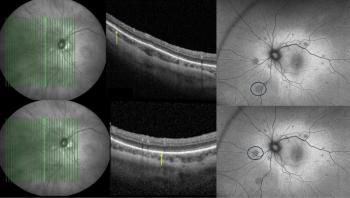
Normalised blood flow index: useful biomarker to detect diabetic retinopathy
Quantitative optical coherence tomography angiography analysis using the index is a useful biomarker for detecting early diabetic retinopathy.
The normalised blood flow index (NBFI) detected using optical coherence tomography angiography (OCTA) of the superficial capillary plexus (SCP) and the deep capillary plexus (DCP) may be a sensitive biomarker to detect diabetic retinopathy (DR), with the latter being the more sensitive of the two.1
Jennifer I. Lim, MD, the Marion H. Schenk Chair, UIC Distinguished Professor of Ophthalmology, Vice Chair for Diversity & Inclusion, University of Illinois at Chicago, reported these findings at the 2023 annual meeting of the American Society of Retina Specialists in Seattle.
A previous study2 found that the blood vessel density (BVD) in both the superficial and deep tissue was a sensitive marker of DR but provides only limited blood flow information compared with blood flow flux (BFF); BVD detects only the presence and absence of flow. In contrast, according to Dr Lim, the BFF is a more robust measure that provides data on both the blood velocity andblood vessel size.3-5
Understanding the BFF
Dr Lim explained that the BFF provides absolute (non-binarised) decorrelation intensity values from OCTA images. The magnitude of the values is affected by background variabilities, such as ocular pigmentation, and noise, such as the eye blink/ movement, which will affect the differential BFF analysis among patients.
So, the bottom line is that the signal needs to be standardised.
With this in mind, Dr Lim and colleagues conducted a retrospective study to establish the normalised NBFI using OCTA and test if that index is sufficiently sensitive for detecting early DR
In this study, the investigators went through a series of steps to reach the NBFI.
They compared the BFF (defined as the mean pixel intensities of the nonbinarised OCTA images), BVD, and NBFI on OCTA images from patients with diabetes mellitus (DM) without diabetic retinopathy (no DR) and DM with mild nonproliferative DR (NPDR) and from healthy controls.
The investigators created a binarised vessel map of the BVD from the OCTA images after using an algorithm to remove background and noise. A NBFI perfusion map was created from the areas of the OCTA images that corresponded to the vessel map; a NBFI noise map was created from the areas of the OCTA images not represented by the vessel map, ie, the inverse of the perfusion map, she explained.
Finally, the NBFI was created by dividing the mean values of the perfusion map by the standard deviation of the noise map.
When the BFF and the NBFI were compared among the study participants, ie, 20 healthy subjects, 15 without DR, and 22 with mild NPDR, the data showed the following results:
- TheBVD of the SCP and DCP differentiated all 3 groups from each other; control vs mild NPDR (p<0.0001) and NoDR vs mild NPDR (p=0.0001).
- The BFF of the DCP differentiated all 3 groups from each other (p=0.007); control vs mild NPDR p<0.0001, NoDR vs mild NPDR (p=0.0117)
- The NBFI of the SCP differentiated all 3 groups from each other; control vs mild NPDR (p<0.0001) and no DR vs mild NPDR (p=0.0002).
- The NBFI of the DCP differentiated all 3 groups from each other; control versus no DR (p=0.0416), control vs mild NPDR (p=0.0093) and no DR vs mild NPDR (p<0.0001).
The take-home messages of the study are that quantitative OCTA analysis using the NBFI of the SCP and DCP is a useful OCTA biomarker for detecting early DR and the NBFI of the DCP is the most sensitive bloodflow parameter to distinguish among eyes with no DR, mild NPDR, and control eyes.
References
Dadzie AK, Le D, Abtahi M, et al. Normalised blood flow index in optical coherence tomography angiography provides a sensitive biomarker of early diabetic retinopathy. Transl Vis Sci Technol. 2023;12:3. doi: 10.1167/tvst.12.4.3.
Alam M, Zhang Y, Lim JI, et al. Quantitative optical coherence tomography angiography features for objective classification and staging of diabetic retinopathy. Retina. 2020;40:322-332.
Abdolahi F, Zhou X, Ashimatey BS, et al. Optical coherence tomography angiography-derived flux as a measure of physiological changes in retinal capillary blood flow. Transl Vis Sci Technol. 2021;10:5.
Choi WJ, Qin W, Chen CL, et al. Characterizing relationship between optical microangiography signals and capillary flow using microfluidic channels. Biomed Opt Express. 2016;7:2709–2728.
Kushner-Lenhoff S, Li Y, Zhang Q, et al. OCTA derived vessel skeleton density versus flux and their associations with systemic determinants of health. Invest Ophthalmol Vis Sci. 2022;63:19 (1-7).
Jennifer Lim, MD is the Marion H. Schenk Chair, UIC Distinguished Professor of Ophthalmology Vice Chair for Diversity & Inclusion, University of Illinois at Chicago. She has no financial interest in this subject matter.
Newsletter
Get the essential updates shaping the future of pharma manufacturing and compliance—subscribe today to Pharmaceutical Technology and never miss a breakthrough.













































